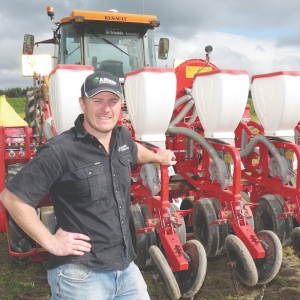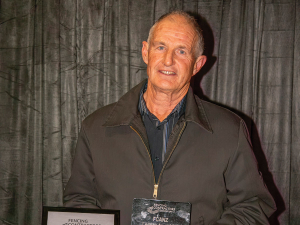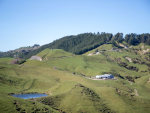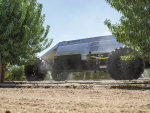But closer inspection shows something different – an invention that adds new meaning to the concept of ‘precision agriculture’.
Linklater specialises in ‘strip tillage’, but has gone one stage further than most by designing and building his own machine – one that attracted interest from farmers nationwide when he demonstrated it at a Beef + Lamb field day earlier this year.
Linklater has a passion for the land, not so much the hands-on farming, but the machinery side of the business. He did a year at Lincoln University, but was also driving harvesters for Watties and was offered a job driving pea harvesters in the UK.
“So I did a couple of seasons going back and forth between England and New Zealand driving pea harvesters and other farm machinery. Then I got offered a job in Australia, initially running harvest crews for a company called Cedenco with tomatoes,” he told Rural News.
“I then moved into the farming side and ended up managing some of the company’s farming operation, where we had 1000ha under drip irrigation in Victoria. I worked for them for five years and then transferred back to Gisborne with Cedenco.”
When Cedenco went into receivership Linklater decided to shift back to Manawatu and establish his own agricultural contracting business. An added motive was that his father and brother were looking at growing fodder beet and Paul, with his knowledge of strip tillage, felt he could make a difference to that trial.
“With my agricultural contracting business it was a case of trying to create a point of difference, to a degree, by developing a niche market. There were many contractors out there planting crops, but it was case of offering a service no one else was offering.”
Strip tillage is a system whereby only strips of a paddock are worked where a crop is later planted. These are sprayed out, but it means 50-60% of the paddock is still available for grazing for up to six weeks before the crop is planted. The other advantage is that the area not worked is hard and makes it easier for tractors to work on if the paddock is wet.
While the concept of strip tillage is not new, the machine Linklater has developed is unique.
“After a lot of trial and error we have designed a strip sprayer that burns out strips in the paddock. As the tractor is running on GPS [the strips are recorded],” he explains. “The machine I have designed goes back in and works that band that’s been sprayed and plants and fertilises it in one pass.
“Other people are running strip tillage machines, but I don’t know of anyone doing everything in one pass,” he adds.
Linklater designed and built his first machine in 2011 and admits it was as much error as trial. “We have tried all sorts of systems to get the soil to be pliable so it’s great for planting into,” he told Rural News.
“We now have a package doing a good job. The advantage over direct drilling is that you get better plant establishment because you are getting worked soil around a seed – versus dropping a seed into a hard slot which is hit-and-miss.”
A ripping tine on the machine goes reasonably deep and allows a root structure to punch through, which gets more moisture, he says. “Because you are doing everything in one pass you are conserving moisture.”









